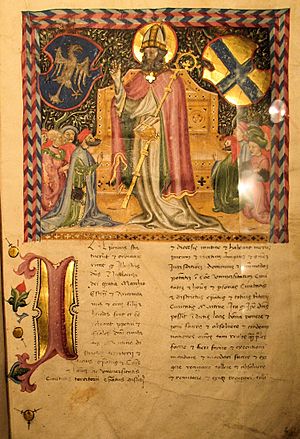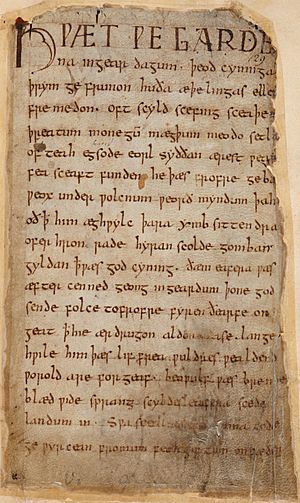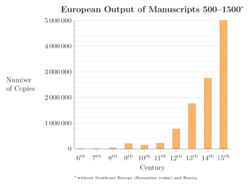Medieval literature facts for kids
Medieval literature means all the written stories, poems, and other works created in Europe and other parts of the world during the Middle Ages. This period lasted about 1,000 years, from around 500 AD (when the Western Roman Empire ended) to the start of the Renaissance (a time of new ideas) in the 14th, 15th, or 16th century. Medieval writings included both religious and non-religious stories. It's a rich and interesting field, covering everything from very sacred texts to funny and playful tales. These works are often grouped by where they came from, the language they were written in, and what kind of story they are.
Contents
What Languages Did People Write In?
Outside of Europe, people wrote medieval literature in many languages. Some of these included Ethiopic, Syriac, Coptic, Japanese, Chinese, and Arabic.
In Western Europe, Latin was the main language for writing. This was because Latin was the language of the Roman Catholic Church, which was very powerful in Western and Central Europe. The Church was also almost the only place where people could get an education. This was true even in parts of Europe that the Romans never ruled.
In Eastern Europe, the Eastern Roman Empire and the Eastern Orthodox Church were very important. Because of them, Greek and Old Church Slavonic became the main written languages.
Most ordinary people in Europe spoke their own local languages, called vernaculars. Some famous stories written in these local languages are still known today. For example:
- The Old English epic Beowulf
- The Middle High German Nibelungenlied
- The Medieval Greek Digenis Acritas
- The Old East Slavic Tale of Igor's Campaign
- The Old French Chanson de Roland
These long poems, called epics, were usually based on older stories that people told out loud. Even though we don't know who wrote the versions we have today, they came from a long tradition of oral storytelling. Stories from Celtic traditions can be found in the Mabinogion and the King Arthur stories. Many other local language stories also survived from Old Norse literature, especially the sagas from Iceland.
Who Wrote These Stories?
Many medieval writings don't have an author's name. This isn't just because documents got lost over time. It's also because writers back then thought differently about who an "author" was. Medieval writers often greatly respected older writers from ancient times and the early Church. They liked to retell and add to stories they had heard or read, rather than making up completely new ones. Even when they did create new stories, they often said they were just passing on something from an "auctor" (an authority or original source). Because of this, the names of individual writers seemed less important, so many major works were never linked to a specific person.
What Kinds of Stories Were There?
Religious Writings
Religious books were the most common type of literature found in libraries during the Middle Ages. Catholic priests and monks were the main thinkers and scholars of society. So, they produced the most literature.
Many hymns (religious songs) from this time still exist today. Religious scholars like Anselm of Canterbury, Thomas Aquinas, and Pierre Abélard wrote long books about religion and ideas. They often tried to connect the teachings of ancient Greek and Roman writers with the Church's beliefs. Stories about the lives of saints, called hagiographies, were also very popular. These stories encouraged people to be devout and warned others.
One book, The Golden Legend by Jacobus de Voragine, was so popular that people reportedly read it more often than the Bible. Francis of Assisi was a great poet, and his followers, the Franciscans, often wrote poetry to show their faith. Dies Irae and Stabat Mater are two very powerful Latin poems about religious topics. Some priests used Goliardic poetry (short, satirical poems) to express their disagreements.
The only widespread religious writing not made by priests was the mystery plays. These plays started as simple re-enactments of Bible scenes. Over time, each mystery play became a village's way of showing key events from the Bible. Local guilds (groups of skilled workers) often controlled the text of these plays. Mystery plays were performed regularly on special feast days, sometimes lasting all day and night.
During the Middle Ages, Jewish people in Europe also had many excellent writers. Maimonides, born in Cordoba, Spain, and Rashi, born in Troyes, France, are two of the most famous and important of these Jewish authors.
Non-Religious Stories
There wasn't as much non-religious (or secular) literature as religious literature during this time. The earliest stories were based on oral traditions, meaning they were told out loud before being written down. Examples include the British Y Gododdin and Preiddeu Annwfn, and the Germanic Beowulf and Nibelungenlied. These stories are about myths or events from the 6th century. However, the written copies we have today are from much later centuries. The people who created and performed these stories were called bards (in Britain/Wales) and scops (among Germanic peoples). They were skilled professionals who worked for kings or nobles, praising heroes from legendary history.
Prose stories (written in regular sentences, not poetry) first appeared in Britain. These included the complex Four Branches of the Mabinogi, which were about royal families and often against war, and the adventure story Culhwch and Olwen. These works were put together from older oral traditions around 1100 AD.
Around the same time, a new type of poetry called "courtly love" became popular in Europe. Traveling singers, known as troubadours and trouvères, earned a living by singing love songs in French, Spanish, Galician-Portuguese, Catalan, Occitan, and Greek. German culture had its own Minnesänger tradition. Courtly love songs often expressed a deep, unfulfilled longing for an ideal woman. But there were also aubades (farewell songs sung by lovers at dawn) and funny little tunes.
After the first epic poems and prose tales, longer poems called chansons de geste were created in the late 11th and early 12th centuries. These poems celebrated conquests, like The Song of Roland and Digenis Acritas. A different kind of story was the chivalric romance. These were adventure stories about amazing things, love, and chivalry (the code of conduct for knights). They told tales from the Matter of Britain (like King Arthur) and the Matter of Rome (stories from ancient Rome).
Political poetry was also present throughout the period. It ranged from the early Armes Prydein (10th-century Britain) to the goliards of the 12th and 13th centuries. These goliards were educated priests who either couldn't or didn't want to work for the Church.
Travel stories were very popular in the Middle Ages. Fantastic tales of faraway lands (often exaggerated or completely made up) entertained people. Society supported sea voyages and trade along coasts and rivers. People also went on pilgrimages to places like Jerusalem, Canterbury and Glastonbury in England, St. David's in Wales, and Santiago de Compostela in Spain. Geoffrey Chaucer's Canterbury Tales, which tells stories of pilgrims traveling to Canterbury, became popular at the end of the 14th century.
The most important Jewish writers of non-religious poetry in the Middle Ages were Solomon ibn Gabirol and Yehuda Halevi. Both were also famous for their religious poems.
Women's Literature
Even though women in the Middle Ages were not treated as equals to men, some women became famous for their writing skills. Religious writing was the easiest path for them. Women who later became saints often published their thoughts, visions, and prayers. Much of what we know about women in the Middle Ages comes from the works of nuns like Clare of Assisi, Bridget of Sweden, and Catherine of Siena.
Sometimes, the religious ideas of women were seen as unusual by those in power. The mystical visions of writers like Julian of Norwich, Mechthild of Magdeburg, and Hildegard of Bingen give us a look into a part of medieval life that was less comfortable for the powerful institutions of Europe. Women also wrote important non-religious texts. Their thoughts on courtly love and society, written by Marie de France and Christine de Pizan, are still studied today for what they tell us about medieval society.
Some women were also important supporters of books and owned large collections. Female book collectors in the 15th century included Alice Chaucer, Duchess of Suffolk; Cecily Neville, Duchess of York; and Lady Margaret Beaufort, Countess of Richmond and Derby. Lady Margaret Beaufort might have also translated texts to show her devotion, as noted by Bishop John Fisher after her death.
Allegory: Stories with Hidden Meanings
Medieval literature used many literary devices, but allegory was especially important. Allegory is a story, poem, or picture that can be interpreted to reveal a hidden meaning, typically a moral or political one. Many medieval writings used allegory to teach lessons or ideas the author wanted to share. They often featured characters or events that represented abstract qualities, ideas, or institutions.
Probably the earliest and most important allegory was the Psychomachia (Battle of Souls) by Aurelius Clemens Prudentius. Other key examples include the Romance of the Rose, Everyman, Piers Plowman, the Roman de Fauvel, and The Divine Comedy.
How Many Medieval Works Survived?
A recent study found that only about 68% of all medieval works have survived until today. Fewer than 40% of English works survived, around 50% of Dutch and French works, and more than 75% of German, Icelandic, and Irish works. This shows how much literature from that time has been lost.
Famous Medieval Books and Authors
- Alexiad, Anna Comnena
- Beowulf, an Anglo-Saxon author (name unknown)
- The Book of the City of Ladies, Christine de Pizan
- The Canterbury Tales, Geoffrey Chaucer
- Consolation of Philosophy, Boethius
- Decameron, Giovanni Boccaccio
- La divina commedia (The Divine Comedy), Dante Alighieri
- Elder Edda, various Icelandic authors
- The Lais of Marie de France, Marie de France
- Il milione (The Travels of Marco Polo), Marco Polo
- Le Morte d'Arthur, Sir Thomas Malory
- Nibelungenlied, a German author (name unknown)
- Piers Plowman, William Langland
- Revelations of Divine Love, Julian of Norwich
- Roman de la Rose, Guillaume de Lorris and Jean de Meun
- Sir Gawain and the Green Knight, an English author (name unknown)
- The Song of Roland, a French author (name unknown)
- Summa Theologiae, Thomas Aquinas
- The Tale of Igor's Campaign, a Russian author (name unknown)
- The Travels of Sir John Mandeville, John Mandeville
- Troilus and Criseyde, Geoffrey Chaucer
- Younger Edda, Snorri Sturluson
See also
 In Spanish: Literatura medieval para niños
In Spanish: Literatura medieval para niños




